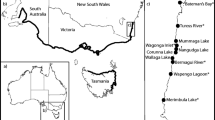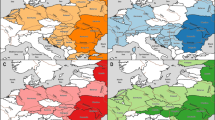Abstract
Although the establishment and spread of non-indigenous species depends upon survival in the face of novel environmental conditions and novel biological interactions, relatively little attention has been focused on the specific role of native predators in limiting invasion success. The European common periwinkle, Littorina littorea, was recently introduced to the Pacific coast of Canada and provides a case study of an introduction into an area with an important predator guild (sea stars) that is functionally minor in the invader’s native habitat. Here, we assess the likelihood of establishment, spread, and negative ecological impact of this introduced gastropod, with an emphasis on the role of native sea stars as agents of biotic resistance. Size frequency distributions and local market availability suggest that L. littorea was most likely introduced via the live seafood trade. Non-native hitchhikers (e.g., the trematode Cryptocotyle lingua) were found on/in both market and field specimens. Laboratory studies and field observations confirmed that L. littorea can survive seasonal low salinity in Vancouver, British Columbia. Periwinkles also readily consumed native Ulva, suggesting that periwinkles could impact native communities via herbivory or resource competition. Unlike native gastropods, however, L. littorea lacked behavioural avoidance responses to Northeast Pacific predatory sea stars (Pisaster ochraceus and Pycnopodia helianthoides), and sea star predation rates on L. littorea were much higher than predation rates on native turban snails (Chlorostoma funebralis) in common garden experiments. We therefore expect periwinkle establishment in British Columbia to be limited to areas with low predator density, as is seen in its field distribution to date. We caution that this conclusion may understate the importance of the L. littorea introduction if it also serves as a vector for additional non-indigenous species such as C. lingua.







Similar content being viewed by others
References
Agoramoorthy G, Hsu MJ (2005) Religious freeing of wildlife promotes alien species invasion. Bioscience 55:5–6
Bertness MD (1984) Habitat and community modification by an introduced herbivorous snail. Ecology 65:370–381
Blakeslee AMH, Byers JE (2008) Using parasites to inform ecological history: comparisons among three congeneric marine snails. Ecology 89:1068–1078
Blakeslee AMH, Byers JE, Lesser MP (2008) Solving cryptogenic histories using host and parasite molecular genetics: the resolution of Littorina littorea’s North American origin. Mol Ecol 17:3684–3696
Buschbaum C (2000) Direct and indirect effects of Littorina littorea (L.) on barnacles growing on mussel beds in the Wadden Sea. Hydrobiologia 440:119–128
Byrnes JE, Reynolds PL, Stachowicz JJ (2007) Invasions and extinctions reshape coastal marine food webs. PLoS ONE 2:e295
Carlson RL, Shulman MJ, Ellis JC (2006) Factors contributing to spatial heterogeneity in the abundance of the common periwinkle Littorina littorea (L.). J Molluscan Stud 72:149–156
Carlsson NOL, Sarnelle O, Strayer DL (2009) Native predators and exotic prey—an acquired taste? Front Ecol Environ 7:525–532
Carlsson NOL, Bustamante H, Strayer DL, Pace ML (2011) Biotic resistance on the increase: native predators structure invasive zebra mussel populations. Freshw Biol 56:1630–1637
Carlton JT (1992) Introduced marine and estuarine mollusks of North America: an end-of-the-20th-century perspective. J Shellfish Res 11:489–505
Carlton JT (2007) Intertidal invertebrates from Central California to Oregon. University of California Press, Berkeley, CA
Chang AL, Blakeslee AMH, Miller AW, Ruiz GM (2011) Establishment failure in biological invasions: a case history of Littorina littorea in California, USA. PLoS ONE 6:e16035
Chapman MG (1999) Are there adequate data to assess how well theories of rarity apply to marine invertebrates? Biodivers Conserv 8:1295–1318
Chapman JW, Carlton JT, Bellinger MR, Blakeslee AMH (2007) Premature refutation of a human-mediated marine species introduction: the case history of the marine snail Littorina littorea in the northwestern Atlantic. Biol Invasions 9:737–750
Chapman JW, Blakeslee AMH, Carlton JT, Bellinger MR (2008) Parsimony dictates a human introduction: on the use of genetic and other data to distinguish between the natural and human-mediated invasion of the European snail Littorina littorea in North America. Biol Invasions 10:131–133
Cheng BS, Hovel KA (2010) Biotic resistance to invasion along an estuarine gradient. Oecologia 164:1049–1059
Choi FMP (2011) Assessing intertidal marine non-indigenous species in Canadian ports. Dissertation, University of British Columbia, Vancouver
Dafforn KA, Glasby TM, Johnston EL (2009) Links between estuarine condition and spatial distributions of marine invaders. Divers Distrib 15:807–821
Davenport J, Davenport JL (2005) Effects of shore height, wave exposure and geographical distance on thermal niche width of intertidal fauna. Mar Ecol Prog Ser 292:41–50
deRivera CE, Ruiz GM, Hines AH, Jivoff P (2005) Biotic resistance to invasion: native predator limits abundance and distribution of an introduced crab. Ecology 86:3364–3376
Dethier MN, Graham ES, Cohen S, Tear LM (1993) Visual versus random-point percent cover estimation: ‘objective’ is not always better. Mar Ecol Prog Ser 96:93–100
Díaz ER, Kraufvelin P, Erlandsson J (2012) Combining gut fluorescence technique and spatial analysis to determine Littorina littorea grazing dynamics in nutrient-enriched and nutrient-unenriched littoral mesocosms. Mar Biol 159:837–852
Elton C (1958) The ecology of invasions by animals and plants. Methuen, London
Galil BS (2007) Loss or gain? Invasive aliens and biodiversity in the Mediterranean Sea. Mar Pollut Bull 55:314–322
Hanna DG (1966) Introduced mollusks of western North America. Occa Pap Calif Acad Sci 48:1–108
Harley CDG (2011) Climate change, keystone predation, and biodiversity loss. Science 334:1124–1127
Held MBE, Harley CDG (2009) Responses to low salinity by the sea star Pisaster ochraceus from high- and low-salinity populations. Invertebr Biol 128:381–390
Holsman KK, McDonald PS, Armstrong DA (2006) Intertidal migration and habitat use by subadult Dungeness crab Cancer magister in a NE Pacific estuary. Mar Ecol Prog Ser 308:183–195
Jacobsen HP, Stabell OB (1999) Predator-induced alarm responses in the common periwinkle, Littorina littorea: dependence on season, light conditions, and chemical labelling of predators. Mar Biol 134:551–557
Levine JM, Adler PB, Yelenik SG (2004) A meta-analysis of biotic resistance to exotic plant invasions. Ecol Lett 7:975–989
Lewis JR (1964) The ecology of rocky shores. English Universities Press LTD, London
Lotze HK, Worm B (2002) Complex interactions of climatic and ecological controls on macroalgal recruitment. Limnol Oceanogr 47:1734–1741
Lotze HK, Worm B, Molis M, Wahl M (2002) Effects of UV radiation and consumers on recruitment and succession of a marine macrobenthic community. Mar Ecol Prog Ser 243:57–66
Lubchenco J (1978) Plant species diversity in a marine intertidal community: importance of herbivore preference and algal competitive abilities. Am Nat 112:23–39
Mack RN, Simberloff D, Lonsdale WM, Evans H, Clout M, Bazzaz FA (2000) Biotic invasions: causes, epidemiology, global consequences, and control. Ecol Appl 10:689–710
McClintock JB (1985) Avoidance and escape responses of the sub-Antarctic limpet Nacella edgari (Powell) (Mollusca, Gastropoda) to the sea star Anasterias perrieri (Smith) (Echinodermata, Asteroidea). Polar Biol 4:95–98
Oliveira MD, Calheiros DF, Jacobi CM, Hamilton SK (2011) Abiotic factors controlling the establishment and abundance of the invasive golden mussel Limnoperna fortunei. Biol Invasions 13:717–729
Paine RT (1966) Food web complexity and species diversity. Am Nat 100:65–75
Paine RT (1969) The Pisaster-Tegula interaction: prey patches, predator food preference, and intertidal community structure. Ecology 50:950–961
Perez KO, Carlson RL, Shulman MJ, Ellis JC (2009) Why are intertidal snails rare in the subtidal? Predation, growth and the vertical distribution of Littorina littorea (L.) in the Gulf of Maine. J Exp Mar Biol Ecol 369:79–86
Petraitis PS (1987) Factors organizing rocky intertidal communities of New England: herbivory and predation in sheltered bays. J Exp Mar Biol Ecol 109:117–136
R Development Core Team (2004) R: a language and environment for statistical computing. R Foundation for Statistical Computing, Vienna
Rilov G, Schiel DR (2006a) Seascape-dependent subtidal-intertidal trophic linkages. Ecology 87:731–744
Rilov G, Schiel DR (2006b) Trophic linkages across seascapes: subtidal predators limit effective mussel recruitment in rocky intertidal communities. Mar Ecol Prog Ser 327:83–93
Rochette R, Dill LM (2000) Mortality, behavior and the effects of predators on the intertidal distribution of littorinid gastropods. J Exp Mar Biol Ecol 253:165–191
Ruiz GM, Fofonoff PW, Carlton JT, Wonham MJ, Hines AH (2000) Invasion of coastal marine communities in North America: apparent patterns, processes, and biases. Annu Rev Ecol Syst 31:481–531
Sax DF, Stachowicz JJ, Brown JH, Bruno JF, Dawson MN, Gaines SD, Grosberg RK, Hastings A, Holt RD, Mayfield MM, O’Connor MI, Rice WR (2007) Ecological and evolutionary insights from species invasions. Trends Ecol Evol 22:465–471
Shinen JS, Morgan SG, Chan AL (2009) Invasion resistance on rocky shores: direct and indirect effects of three native predators on an exotic and a native prey species. Mar Ecol Prog Ser 378:47–54
Shurin JB, Borer ET, Seabloom EW, Anderson K, Blanchette CA, Broitman B, Cooper SD, Halpern BS (2002) A cross-ecosystem comparison of the strength of trophic cascades. Ecol Lett 5:785–791
Sorte CJB, Jones SJ, Miller LP (2011) Geographic variation in temperature tolerance as an indicator of potential population responses to climate change. J Exp Mar Biol Ecol 400:209–217
Steinhauser F (1979) Climatic atlas of North and Central America. World Meteorological Organization, UNESCO Cartographia, Budapest
Thornber C (2007) Associational resistance mediates predator-prey interactions in a marine subtidal system. Mar Ecol Evol Persp 28:480–486
Todd ME (1964) Osmotic balance in Littorina littorea, L. littoralis, and L. saxatilis (Littorinidae). Physiol Zool 37:33–44
Trussell GC, Ewanchuk PJ, Bertness MD (2003) Trait-mediated effects in rocky intertidal food chains: predator risk cues alter prey feeding rates. Ecology 84:629–640
Underwood AJ (1997) Experiments in ecology: their logical design and interpretation using analysis of variance. Cambridge University Press, Cambridge
Whittington RJ, Chong R (2007) Global trade in ornamental fish from an Australian perspective: the case for revised import risk analysis and management strategies. Prev Vet Med 81:92–116
Wood CL, Byers JE, Cottingham KL, Altman I, Donahue MJ, Blakeslee AMH (2007) Parasites alter community structure. Proc Natl Acad Sci USA 104(22):9335–9339
Acknowledgments
We thank D. Reid for assisting with the identification of the snails. R. Gooding brought the L. littorea population at Acadia Beach to our attention. The students in the University of British Columbia’s Experimental Biology of Invertebrates course assisted with data collection for the herbivory trials. M. Frey kindly surveyed sites at Clover Point (Victoria) and Sidney. Additional assistance in the field was provided by B. Arney, F. Choi, C. Murray, Z. Harley, C.G. Harley, M. Harley, B. Harley, J. Nelson, and M. Picard. R. Whippo assisted with the statistical analyses. Comments by P. Kraufvelin and four anonymous referees improved the manuscript. Funding for this work was provided by a National Science and Engineering Research Council (NSERC) Discovery Grant to CH and by the Canadian Aquatic Invasive Species Network (an NSERC Strategic Network Grant).
Author information
Authors and Affiliations
Corresponding author
Additional information
Communicated by P. Kraufvelin.
Rights and permissions
About this article
Cite this article
Harley, C.D.G., Anderson, K.M., Lebreton, C.AM. et al. The introduction of Littorina littorea to British Columbia, Canada: potential impacts and the importance of biotic resistance by native predators. Mar Biol 160, 1529–1541 (2013). https://doi.org/10.1007/s00227-013-2206-8
Received:
Accepted:
Published:
Issue Date:
DOI: https://doi.org/10.1007/s00227-013-2206-8




